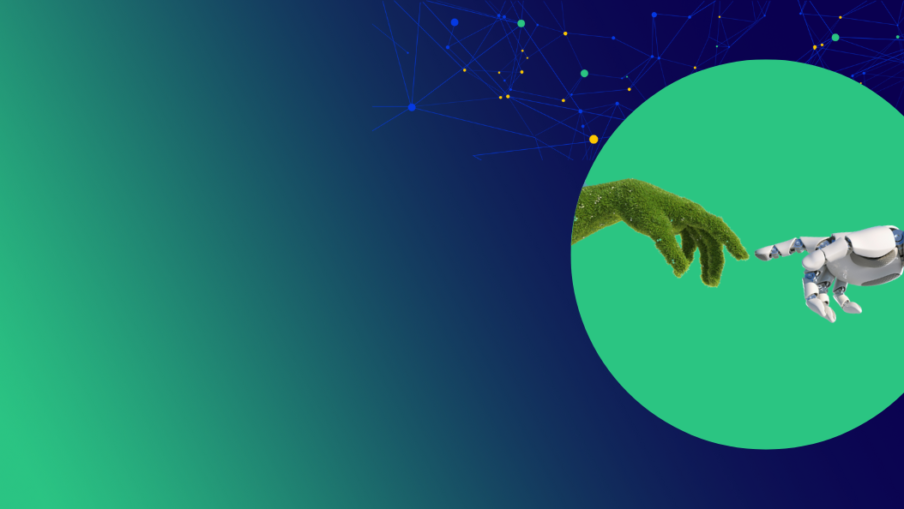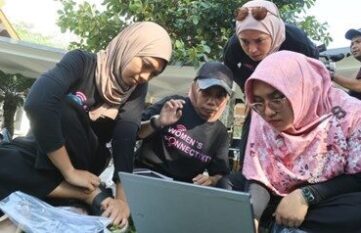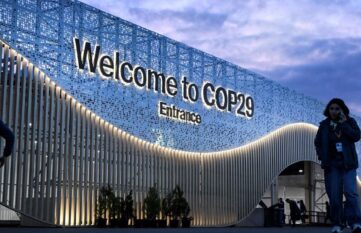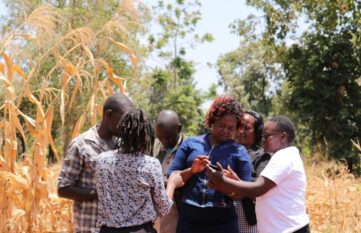Digital and green transformations are enormous drivers of development. But only when combined do they unleash their true power.
The cotton seedlings must feel like they’re in an open-air disco. Strobe-like light from five spotlights scans the green in the ground; they hang from a scaffold. It moves slowly forward in a field in India – the metal hangs across in front of a small tractor and 25 nozzles spray a liquid; the TartanSense technology precisely checks how much pesticide or fertilizer needs to be applied to the soil. Because spraying can be done differently. Gone can be the time when people spray fields by hand, endangering themselves and the soil, leaching it out and poisoning it. The small tractor uses artificial intelligence to apply only what is necessary – saving up to 60 percent of resources. In the neighboring field, another company’s app analyzed photographs of leaves taken by farmers. CottonAce Pest Management describes to them exactly how badly their crops are affected by pests and what they can do about it and when.
This field scene describes not the agriculture of the future, but of the present – with implementations supported by German development cooperation. Small farmers have long since started using digital technologies, and it’s not just about better harvests and yields, but also about protecting the environment, the soil and the climate. Digitization and climate: Too often, two transitions have been thought of as separate from each other, yet together they make the real difference: the digital and the green towards a climate-friendly future – within the natural limits of our planet. Together, they form the Twin Transition. Many projects are still in their infancy, just being launched.
In the public perception, digitization usually shows two faces. For some, it is the magic word of technical progress, a booster of economic growth – and for others, job destruction and general uncertainty, a departure from a past, supposedly better world. But digital transformation has another significance that is widely underestimated. It is part of the solution to one of the biggest problems facing humanity: climate change.
For Germany alone, a study commissioned by the digital association Bitkom found that the targeted and accelerated use of digital solutions can help decisively in the fight against climate change. The study concludes that this can reduce 152 megatons of CO2 – equivalent to 41 percent of what Germany needs to save in order to meet the climate targets it has set itself by 2030. Of course, this also has implications for development policy. Because if digital transformation is part of the climate crisis solution, it is everywhere. Countries in the Global South in particular can leapfrog steps with digital support and embark on sustainable development paths. It offers a unique opportunity to rethink environmental sustainability, social inclusion, green economy, and thus how to shape the future. It enables the comprehensive and transformative change needed to achieve the goals of the Paris Agreement and Agenda 2030. Twin Transition is the biggest driver of change – also and especially in development cooperation.
The BMZ has recognized the opportunities and is aware of its responsibility in this thematic field. To this end, the Twin Transition initiative “Climate and Digitalization” was launched back in 2021. In a first step, EUR 15 million was used to unfold the Twin Transition through targeted scaling up of selected initiatives.
What this looks like can be observed on several continents. In Indonesia, mobile technologies such as satellites will in future help to monitor tropical forests and identify emission sources at an early stage. Satellites identify climate change-induced land-use changes and highlight adaptation strategies. Finally, blockchain-based carbon market technologies could track and verify captured emissions. Many of these solutions have emerged in collaboration with innovative digital companies. This potential is also driving the GSMA Mobile Innovation Hub, run jointly with the Indonesian government and the local private sector, which promotes digital innovation at the intersection of mobile and sustainable development: Startups as innovation incubators are called upon to work on local challenges – such as managing e-waste or protecting forests. Or in Rwanda, where heavy rains regularly cause landslides: An Artificial Intelligence-based optical monitoring tool monitors the soils and detects impending avalanches; it was implemented with the help of GIZ and now offers the opportunity to take preventive countermeasures. Or in Uganda, where numerous rural areas are not sufficiently electrified and where this need can again be identified using artificial intelligence (AI) and combined with suitable energy solutions – so that electricity can flow there efficiently. AI also helps in the search for renewable energy solutions for these regions.
It is always important to keep in mind that digital transformation itself also has downsides first, namely through its huge hunger for energy and resources. Twin Transition is thinking along the lines of how to reduce greenhouse gas emissions from data centers and devices. After all, the digital sector contributes about as much to emissions as the aviation sector. The computing power needed to perform a Google search, for example, is 0.3 watt-hours – the equivalent of one energy-saving light bulb burning for an hour. And one hour of watching a movie on Netflix is equivalent to the consumption of a small car driving one kilometer.
Meanwhile, the Twin Transition has also arrived at the big movers and shakers. At this year’s COP 27 global climate conference in Sharm El-Sheikh, Egypt, participating countries discussed their respective needs in a dedicated panel. At the session of the COP 27 organizer UNFCCC “Global south – global north cooperation on the digital and green twin transition”, discussions were held on paper reduction processes in Rwanda, digital solutions for climate change adaptation in the particularly vulnerable island nation of the Dominican Republic, circular economy and streamlined data traffic. Digitalization is a human project. Whether we like it or not, we are on an unstoppable journey into the future. And we decide which waypoints emerge on that journey. Twin Transition is a compass in this process.



